Defending On-Ball Screens based on the Shot-Clock: Advanced Tactics in Defence
Defending On-Ball Screens is one of the many different areas that are usually of concern for many coaches. There is a need to be able to guard a screen with a number of different strategies, for different situations or to counter offensive player preferences. However, as a defending team there needs to be an acknowledgement of what the individual defensive players can do effectively. If a team’s defensive ability cannot match that of the offensive team then there will always be an advantage give to the opposition when defending.
The first step bringing advanced tactics on board when defending on-ball screens is to have options. By having different defensive strategies a team will have choices and continue to be able to be dynamic in dealing with the offensive strengths of their opposition. One of the poorest situations a coach can be in is during a game running out of options to try to limit the style of play of their opposition.

When defending on-ball screens the most common tactics are:
Going Over: Where the on-ball defender goes over the screen splitting the ball handler and screener and in effect sliding between the two to maintain a legal guarding position. Very difficult to achieve if the offensive players execution of the screening technique is good.
Going Under: this is where the ball defender breaks off contact with the ball handler and moves under the screen to regain a guarding position of the player on the opposite side of the screener. This tactic is problematic against teams with effective outside shooters who can step back from the screen for an unchallenged three-point shot.
Switching: This is where the defenders swap defensive assignments and maintain a one on one guarding situation. The most significant issue with this strategy is the possible player position mismatch that can occur.
Doubling: This tactic involves both defensive players involved in defending the screen trap the ball handler. Issues associated with this strategy revolve around off the ball player rotations to cover the now free offensive player who set the screen.
Teams often choose to have a particular tactic as being their regular strategy for dealing with defending on-ball screens. A more flexible strategy is to teach all four options and then choose which options suits best the opposition you are facing. By having options a team can be more dynamic and proactive in searching for a way to contain, disrupt or nullify an oppositions play.
A more advanced tactic for defending on-ball screens is to change the choice of how to guard depending on the timing of the shot clock. This strategy allows for a mixture of tactics to be shown to an offensive team during one possession, causing confusion and frustration at not being able to find a suitable counter to the defensive teams play.
The manipulation of the timing for which tactic to choose also provides a situational appropriate solution. As the shot clock is winding down the intensity and speed of play often makes “going over” the screen very difficult. An easier counter to the increased speed of play might be to “switch” when defending on-ball screens.
As an example on how to mix the defending on-ball screens up and play multiple tactics in the same possession a breakdown of a twenty-four second shot could be:
24 – 18 Seconds: Double
18 – 8 Seconds: Over/Under
8 – 0 Seconds: Switch
By using this type of strategy when defending on-ball screens, offensive teams will find it difficult to play against an ever-changing defensive strategy. Imagine trying to diagnose what is happening to your team when faced with this type of strategy.
This is an advanced tactic and requires time and significant preparation to implement effectively. Learning how to defend on-ball screens is one step, being able to use multiple defences is another.
Related articles







